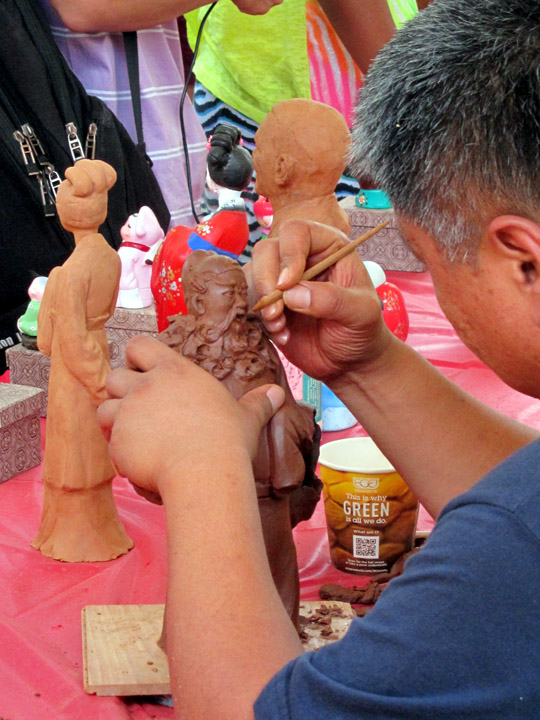Exploring China and Kenya at the Smithsonian Folklife Festival

It’s not every day that you can walk from Kenya to China, but that’s what I did this Saturday. Every summer for two weeks, the National Mall is DC is transformed into a center for global culture when it hosts the Smithsonian Folklife Festival. Over 100 artisans, musicians, performers, and chefs take up residence and share their national traditions with Washington DC. The rich cultures of Kenya and China were presented this year and I had a wonderful time exploring the festivities!

The Flower Plaque gate made of bamboo, paper, and plastic welcomes visitors into the Chinese section of the Festival.
Festival Structure
The festival park is broadly separated into two national sections each with their own decorations. For example, the Kenyan grounds feature a couple traditional Pokomo shelters. There are also numerous tents for traditional craft demonstrations. The respective food concession areas feature specialties such as grilled goat with ugali (cornmeal mash), fried lentils, and chicken curry for Kenya, and tofu, lo mein, pork dumplings and a coconut mango desert for China.
At the “People’s Park” in the Chinese section, you can play games like badminton and watch martial arts and dance performances throughout the day. On the Kenyan side, it is hard to miss the ostrich feather headdresses of the roving Ramogi Dancers would spontaneous break into dance as you can see below.
Performances
The Folklife Festival has several performance stages for musical and theater groups. I made sure to see the Zhejiang Wu Opera Troupe from the Zhejiang Province just south of Shanghai. Enhanced by dramatic make-up and costumes, the choreography was stylized and very precise. In this skit below, a warrior hunts a thief at night leading to some comical near misses as he moved stealthily from grand pose to pose.
In another routine, a dancer used a long scarf to create artistic shapes that floated around her.
As great as the Opera was, I just adored the Quanzhou Puppet Troupe! Expressive and playful, the puppets could pick up objects, performed acrobatics, and definitely charmed the audience.
Founded in 1932 in the Fujian Province, this group is keeping alive a nearly thousand year tradition of marionette performance in China.
After the show, the puppet troupe appeared at the Children’s area to give visitors a closer look at the characters.
Up close, I could appreciate the elaborate control system for each figure. There were 20 or so strings for each human puppet! The puppeteers were incredible and quickly “disappeared” once the performance began.
These hand-made puppets were crafted with amazing attention to detail. Much like humans who wear lion costumes for dance performances, the lion puppet had a little person inside.
Arts and Crafts
I have always enjoyed exploring the craft areas at the Folklife Festival. It is a wonderful opportunity to interact with the artisans themselves and learn about the traditional arts and techniques that they are keeping alive. In the Kenyan area, I really liked the plaster wall sculptor. His decorative domestic elements add a flash of creativity to otherwise utilitarian buildings.
There are also several participants who used recycled materials like old flip-flops, glass bottles, or aluminum to create pieces of art. I also met a basket weaver who used water hyacinth rope for his pieces. Water hyacinth is actually an invasive, non-native plant that has started to choke Lake Victoria, so by removing the plant and using it as an artistic material, he has found a positive solution for a local problem.
The Chinese artists at the Festival practiced a variety of decorative arts including embroidery, calligraphy, and sculpting. Whether it was kite decoration, creating dough figures, or paper cutting, there was a overarching attention to detail and an emphasis on technique and beauty.
Luckily the Folklife Festival continues until July 6, 2014 because there are a lot more musical groups and cooking demonstrations for me to see! If you are in DC for the 4th of July holiday, be sure to visit this cultural festival and celebration of art and folk tradition in Kenya and China!
—-
You can also learn about my “visit” to Hungary as part of the 2013 Folklife Festival.


















Trackbacks & Pingbacks